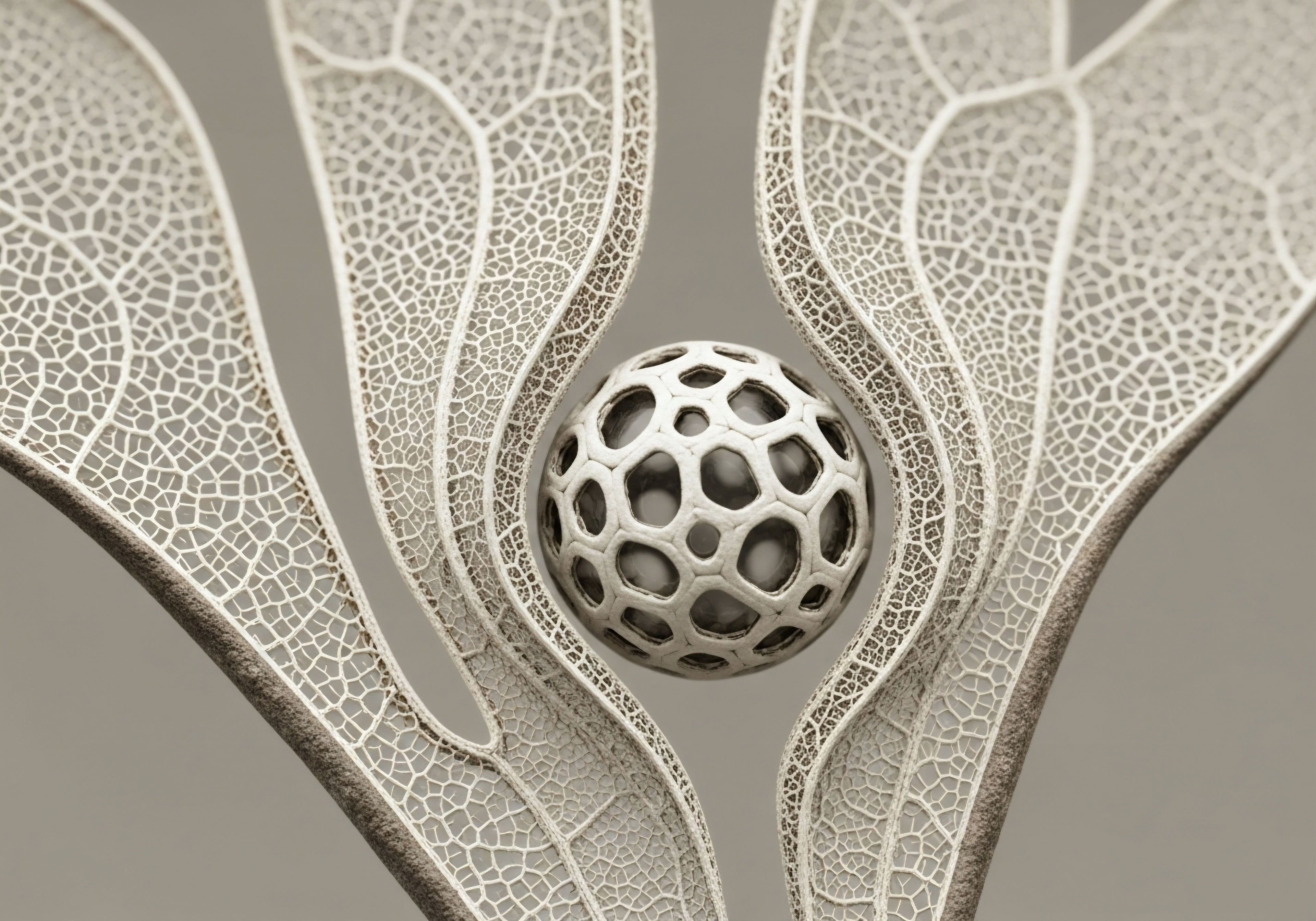

Fundamentals
That recurring ache in your shoulder, the knee that gives way without warning, the frustrating cycle of injury and rehabilitation ∞ these are experiences you know intimately. You have followed the recovery plans, performed the strengthening exercises, and still, your body feels fragile.
This pattern of recurrent musculoskeletal injury points toward a deeper conversation happening within your body, one conducted in the silent language of hormones. Your tissues, from the dense ligaments holding your joints together to the powerful muscles that move you, are not static structures. They are dynamic, living materials in a constant state of breakdown and repair. Hormones are the chief regulators of this entire construction project.
Think of your body’s tissues as a complex and vital infrastructure. Testosterone functions as the master architect and lead construction foreman, directly stimulating the synthesis of collagen, the protein that gives tendons and ligaments their strength and resilience. When testosterone levels are optimal, this building process is robust, creating tissues that can withstand the demands of movement and load.
Estrogen, in turn, acts as a sophisticated materials regulator, influencing the quality and characteristics of that collagen. It supports collagen production, which is essential for tissue health, yet its fluctuations can also alter the laxity and stiffness of ligaments, a critical factor in joint stability. Then there is cortisol, the hormone associated with stress.
In the context of tissue health, elevated cortisol acts like a demolition crew, actively breaking down structural proteins and inhibiting the very repair processes needed to maintain the integrity of your musculoskeletal system.
Hormones are the invisible architects of your physical resilience, dictating how your tissues are built, maintained, and repaired.

The Cellular Blueprint for Strength
Every tendon, ligament, and muscle fiber in your body is assembled from a blueprint encoded in your DNA, but hormones are what give the orders to begin and sustain the building process. The sensation of a ‘weak’ or ‘unstable’ joint often begins at this microscopic level.
When the hormonal signals for repair are weak or disrupted, the tissue that is rebuilt after minor, everyday stress is of a lower quality. Over time, this cumulative deficit in structural integrity means the tissue’s capacity to handle force is diminished. A movement that was once effortless can become the trigger for a significant injury. This is the biological reality behind the feeling that your body is betraying you; it is a direct consequence of a compromised internal environment.
Understanding this connection is the first step in changing the narrative. The persistent injuries are not a sign of personal failure or bad luck. They are valuable data points, signaling a systemic imbalance that can be identified, understood, and addressed. By viewing your body through this lens, you can begin to ask more precise questions and seek solutions that target the root cause of the vulnerability, moving beyond the endless cycle of treating symptoms.


Intermediate
To truly grasp why your body may be predisposed to injury, we must examine the specific mechanisms through which hormonal imbalances compromise tissue integrity. These are not abstract concepts; they are concrete biological processes with measurable effects on your physical structure. The strength of a ligament or the healing capacity of a muscle is a direct reflection of the hormonal environment in which it exists. A disruption in this environment creates a tangible, physical vulnerability.

Testosterone the Anabolic Signal for Tissue Integrity
Testosterone’s role extends far beyond its functions in reproduction. It is a primary anabolic signal, meaning it instructs the body to build and repair. In the context of musculoskeletal health, its most vital function is the stimulation of collagen synthesis. Collagen is the fundamental protein that forms the fibrous network of tendons and ligaments, giving them their tensile strength. When testosterone levels are low, a condition known as hypogonadism, this anabolic signal is weakened.
- Reduced Collagen Production With insufficient testosterone, fibroblasts ∞ the cells responsible for producing collagen ∞ become less active. The result is tissue that is slower to heal and inherently weaker in its structure.
- Impaired Muscle Mass Testosterone is also critical for maintaining muscle mass. Weaker muscles provide less dynamic support to joints, placing greater stress on ligaments and tendons to maintain stability, further increasing injury risk.
- The TRT Intervention For men experiencing these symptoms, Testosterone Replacement Therapy (TRT) is designed to restore this foundational anabolic signal. A typical protocol involving weekly injections of Testosterone Cypionate, often paired with Gonadorelin to maintain testicular function, aims to re-establish the physiological levels needed for robust tissue maintenance and repair. For women with low testosterone, a much smaller weekly dose can provide similar benefits for tissue health and overall vitality.

Estrogen the Double Edged Sword of Joint Laxity
In women, the relationship between hormones and musculoskeletal injury is particularly complex, with estrogen playing a central role. Estrogen is protective of tissue in many ways, including promoting collagen synthesis. However, fluctuations in estrogen levels, particularly the surges that occur during the menstrual cycle, can significantly alter the biomechanical properties of ligaments. High estrogen concentrations have been shown to increase joint laxity by reducing the cross-linking between collagen fibrils. This creates a temporary period of increased vulnerability.
Optimal hormonal balance provides the precise instructions your cells need to build strong, resilient, and functional tissues.
This phenomenon helps explain the higher incidence of certain injuries, like ACL tears, in female athletes. The ligament itself becomes more pliable and less stiff, reducing its ability to resist shearing forces. For women in perimenopause and post-menopause, the decline in estrogen removes its protective effects on bone density and collagen maintenance, while hormonal optimization protocols, which may include progesterone and low-dose testosterone, aim to restore a more stable and protective hormonal environment.

Cortisol the Catabolic Force of Chronic Stress
If testosterone builds tissue, cortisol breaks it down. Chronic stress, whether from life circumstances, overtraining, or poor sleep, leads to persistently elevated levels of cortisol. This hormone has a potent catabolic effect on the body, directly undermining musculoskeletal health.
Cortisol actively inhibits the function of fibroblasts, suppressing collagen synthesis. It also promotes the breakdown of existing proteins in muscle and connective tissue to provide energy, a process called gluconeogenesis. The outcome is a net loss of tissue integrity. Tendons and ligaments become weaker and more brittle, and muscle mass declines. This creates a classic scenario for overuse injuries, where tissues can no longer withstand their normal workload and begin to break down.
| Hormone | Primary Role in Tissue Health | Effect of Imbalance | Clinical Consideration |
|---|---|---|---|
| Testosterone | Stimulates collagen synthesis and muscle growth. | Low levels lead to weaker tendons, ligaments, and reduced muscle support. | TRT can restore anabolic signals for tissue repair. |
| Estrogen | Supports collagen synthesis but can increase joint laxity at high levels. | Fluctuations can create periods of ligament vulnerability; low levels weaken bone and collagen. | Understanding cyclical changes is key for female athletes; HRT can be protective post-menopause. |
| Cortisol | Manages stress response. | Chronically high levels inhibit collagen synthesis and actively break down tissue. | Stress management and lifestyle interventions are critical to lower catabolic load. |


Academic
A sophisticated analysis of recurrent musculoskeletal injury requires moving beyond systemic hormonal levels to the cellular and molecular environment of the tissue itself. The integrity of a tendon or ligament is ultimately determined by the health and composition of its extracellular matrix (ECM).
The ECM is a complex, dynamic network of proteins and other molecules, with collagen as its primary structural component. Hormones function as master regulators of ECM homeostasis, directly influencing the gene expression, synthesis, and degradation of its key constituents. An imbalance in these hormonal signals leads to a pathological state of the ECM, creating a biomechanically deficient tissue that is predisposed to failure under physiological loading.

The Extracellular Matrix a Hormonally Regulated Environment
The resilience of connective tissue is a direct function of the density, organization, and cross-linking of its collagen fibrils. This entire architecture is managed at the cellular level by fibroblasts, and these cells are exquisitely sensitive to hormonal signaling.
- Androgen and Estrogen Receptors Fibroblasts within tendons and ligaments contain both androgen and estrogen receptors. When testosterone binds to its receptor, it initiates a signaling cascade that upregulates the transcription of genes for Type I and Type III collagen, the primary building blocks of tendons. This is the molecular basis for testosterone’s anabolic effect on connective tissue. Similarly, estrogen binding can modulate collagen synthesis, although its effects are more complex, also influencing the expression of enzymes like lysyl oxidase, which is responsible for forming the covalent cross-links that give the ECM its tensile strength.
- Glucocorticoid-Mediated ECM Degradation Cortisol, a glucocorticoid, exerts its catabolic effects by binding to glucocorticoid receptors on fibroblasts. This binding event has a dual negative impact. It transcriptionally represses the genes for collagen production. Simultaneously, it upregulates the expression of matrix metalloproteinases (MMPs), a family of enzymes that actively degrade existing collagen and other ECM proteins. The result is a molecular environment where tissue breakdown outpaces synthesis, leading to a progressive weakening of the structure.

What Are the Advanced Protocols for Tissue Regeneration?
When the endogenous hormonal signaling for repair is compromised, exogenous therapies can be used to directly stimulate regenerative pathways. This is the domain of peptide therapy, particularly the use of growth hormone secretagogues (GHS). These are small proteins that can stimulate the pituitary gland to release growth hormone (GH), a powerful agent for tissue repair.
Growth hormone itself, and its primary mediator, Insulin-like Growth Factor 1 (IGF-1), are potent stimulators of fibroblast activity and collagen synthesis. By elevating GH levels in a controlled, pulsatile manner that mimics the body’s natural rhythm, GHS peptides can directly enhance the healing and fortification of the ECM.
The molecular conversation between hormones and cells determines the ultimate strength and resilience of your physical form.
| Peptide Combination | Mechanism of Action | Primary Therapeutic Goal | Typical Administration |
|---|---|---|---|
| CJC-1295 / Ipamorelin | CJC-1295 is a GHRH analog that increases GH pulse amplitude. Ipamorelin is a ghrelin mimetic that increases GH pulse frequency. | Sustained, synergistic elevation of GH and IGF-1 to promote systemic tissue repair, collagen synthesis, and cellular regeneration. | Subcutaneous injection, typically administered at night to align with natural GH release cycles. |
| Tesamorelin | A potent GHRH analog known for its robust effect on GH levels. | Often used for significant deficits in GH, enhancing muscle protein synthesis and stimulating lipolysis. | Daily subcutaneous injection. |
| MK-677 (Ibutamoren) | An orally active, non-peptide ghrelin mimetic. | Long-acting elevation of GH and IGF-1, promoting muscle anabolism and improving bone density. | Oral daily administration. |
These protocols represent a targeted intervention at the molecular level. By amplifying the body’s own regenerative signals, they can help overcome the inhibitory effects of high cortisol or the insufficient anabolic drive from low testosterone.
The combination of CJC-1295 and Ipamorelin, for instance, is particularly effective because it stimulates GH release through two separate pathways, creating a powerful synergistic effect on the cellular machinery responsible for rebuilding a strong and resilient extracellular matrix. This approach shifts the focus from merely managing injury to actively remodeling the biological terrain to prevent its recurrence.

References
- Leblanc, D. R. & Schneider, M. (2017). The effect of hormones on tendon and ligament biology and healing. The Journal of the American Academy of Orthopaedic Surgeons, 25(10), 685-693.
- Hansen, M. & Kjaer, M. (2016). Sex Hormones and Tendon. In Metabolic Influences on Risk for Tendon Disorders (pp. 139-157). Springer, Cham.
- Chidi-Ogbolu, N. & Baar, K. (2019). Effect of estrogen on musculoskeletal performance and injury risk. Frontiers in physiology, 9, 1834.
- Kuo, C. K. & Tuan, R. S. (2008). Mechanoactive tenogenic differentiation of human mesenchymal stem cells. Tissue Engineering Part A, 14(10), 1615-1627.
- Li, H. Luo, J. Wang, C. & Zhang, W. (2022). Glucocorticoid-induced tendon and ligament impairments ∞ Mechanisms and therapeutic strategies. Journal of Orthopaedic Research, 40(4), 875-887.
- Sinha-Hikim, I. Artaza, J. Woodhouse, L. Gonzalez-Cadavid, N. & Bhasin, S. (2002). Testosterone-induced increase in muscle size in healthy young men is associated with muscle fiber hypertrophy. American Journal of Physiology-Endocrinology and Metabolism, 283(1), E154-E164.
- Veldhuis, J. D. & Bowers, C. Y. (2010). Integrating GHRH, ghrelin, and GH secretagogues in the clinical management of GH deficiency. Pituitary, 13(1), 69-76.
- Sigalos, J. T. & Pastuszak, A. W. (2018). The safety and efficacy of growth hormone secretagogues. Sexual medicine reviews, 6(1), 45-53.
- Beynnon, B. D. Johnson, R. J. Abate, J. A. Fleming, B. C. & Nichols, C. E. (2005). The effect of estradiol and progesterone on knee and ankle joint laxity. The American journal of sports medicine, 33(9), 1298-1304.
- Gomez, C. R. Nomellini, V. Faunce, D. E. & Kovacs, E. J. (2017). Innate immunity and aging. Experimental Gerontology, 105, 62-68.

Reflection
You arrived here carrying the weight of your physical experiences ∞ the frustration of repeated setbacks, the confusion of a body that feels unreliable. The information presented here offers a new framework for understanding those experiences. It recasts the narrative from one of random misfortune to one of biological logic. Your body has been communicating its needs through the language of symptoms. Now, you have begun to learn that language.

What Is Your Body’s True Potential for Resilience?
This knowledge is a tool. It allows you to look at your health not as a series of disconnected problems, but as an integrated system. The path forward involves continuing this investigation, applying this understanding to your own unique biology. The goal is a body that does not simply avoid injury, but one that possesses a deep, cellular resilience.
This is the foundation upon which a life of vitality and unrestricted function is built. The next step in your journey is to ask how these principles apply directly to you.



